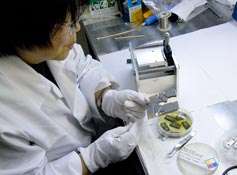Pulling the Strings for the LCLS

Technician Yung-Yung Sung huddles over her desk twisting carbon wires—each half the diameter of a single strand of human hair—along curved grooves on a ceramic plate. Even Sung's skilled fingers can't prevent wires from skittering rebelliously out of grooves and, at times, coiling up or breaking. Fitting the wires properly takes hours, and sometimes days.
Sung's detailed handiwork is well worth the effort, however, as it completes a device vital to the Linac Coherent Light Source (LCLS). The palm-sized device, called a Beam Finder Wire (BFW) card, ensures that LCLS X-rays will form a concentrated beam, a tiny fraction of a millimeter wide, over a 100-meter trajectory.
"There are a lot of people making different contributions to this small—but very important—piece of hardware," Physicist Clive Field said. "Without all of them it wouldn't happen at all."
The process of creating a BFW card begins with a machine, programmed with geometric code, that cuts a series of holes, slots and curved grooves into the surface of a ceramic slab. Then, if the machine's work is accurate to about a thousandth of an inch on critical dimensions, the white card is coated with an alloy mixture that gives it a dark gray outer layer. Only after this protective layer is applied does the card come to Sung for the final touches.
Once completed cards have passed additional inspections and precision measurements, they are mounted on machines built by collaborators from Argonne National Laboratory.
When the LCLS is up and running, the machinery will move wires in steps across the trajectory of the electron bunches in the beam pipe. When wires connect with pulses from the beam, the interaction will scatter a few electrons and these scattered particles will be picked up in a detector.
By detecting these scattered particles and noting the wire position when it intercepts the center of the electron beam, researchers will be able to locate the beam to within an astoundingly small uncertainty: the width of a human hair horizontally and a quarter of this vertically.
Wire card scanners are one of a suite of diagnostic detectors designed to give LCLS operators the highest degree of control possible over the electron beam. The undulators, where the X-rays are produced, require that the electron beam adhere to a very rigid set of parameters before X-ray laser light can even begin to be produced. Knowing the electron beam's precise position will allow undulator sections to be accurately aligned, so X-rays will follow the correct trajectory along its 100 meter length.
"The wires will get you to the point where you have an X-ray signal to work with," said Field. "But it will only be the beginning of producing LCLS X-rays in a coherent manner."
Source: by Matt Cunningham, SLAC



















